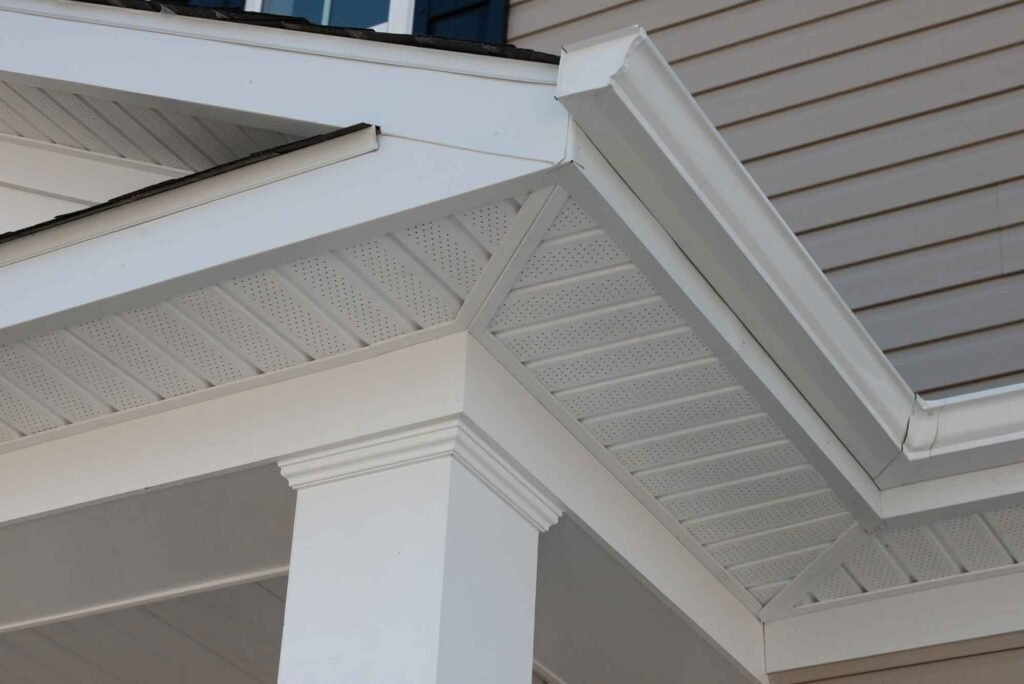Soffit vents are important for keeping your home comfortable and safe. These vents are placed under the roof eaves to let fresh air flow into your attic. This airflow helps prevent moisture buildup and keeps the temperature balanced, which can save you money on energy bills.
When you have proper soffit vents, your attic stays cooler in the summer and warmer in the winter. This not only protects your roofing materials but also helps create a cozy living space. Let’s explore how soffit vents work and why they are essential for your home.
The Key Benefits of Installing Soffit Vents
Installing soffit vents can bring many benefits. First, they improve air circulation in your attic. Good airflow keeps your home cooler in summer and warmer in winter. This helps your heating and cooling systems work better.
Another benefit is moisture control. Soffit vents help prevent condensation, which can lead to mold growth. This keeps your family safe from health issues caused by mold spores.
More Advantages of Soffit Vents
- Energy Efficiency: Lower energy bills because your home maintains a steady temperature.
- Roof Longevity: Protects your roof from premature wear.
- Comfort: Creates a more pleasant living space for your family.
With all these benefits, installing soffit vents is a smart choice for any homeowner.
Where to Place Soffit Vents for Maximum Effectiveness
Proper placement of soffit vents is essential. You want them to be evenly spaced along the eaves of your roof. This ensures that fresh air can flow in evenly and effectively.
Avoid placing vents near obstructions, such as insulation or debris. These can block airflow, making your ventilation system less effective. Keeping the area clear allows your vents to do their job properly.
Ideal Placement Tips
- Even Distribution: Spread vents out to prevent hotspots.
- Clear Space: Ensure no insulation or debris blocks the vents.
- Follow Guidelines: Use manufacturer recommendations for best results.
When you place your soffit vents correctly, you create a healthy attic environment.
Easy Steps to Install Soffit Vents Like a Pro

Installing soffit vents is a straightforward project. First, you need to determine how many vents you will need. A good rule of thumb is one square foot of ventilation for every 150 square feet of attic space.
Once you know how many vents you need, choose the right type. Options include continuous strip vents or individual panels. Each type has its own benefits depending on your roof design.
Step-by-Step Installation
- Measure Your Attic: Know the size of your attic to calculate vent needs.
- Mark Vent Locations: Use chalk lines to plan where vents will go.
- Cut Openings Carefully: Use appropriate tools to avoid damaging your roof.
- Seal Edges: Apply caulk around vents to prevent leaks.
Following these steps can help you successfully install soffit vents and improve attic ventilation.
Common Mistakes to Avoid When Installing Soffit Vents
While installing soffit vents can be easy, some common mistakes can occur. One mistake is not measuring the attic size properly. This can lead to too few or too many vents.
Another issue is ignoring the airflow path. If vents are placed too close to each other, they won’t work effectively. Always ensure that there’s a clear path for air to flow.
Avoiding Installation Pitfalls
- Take Accurate Measurements: Always double-check attic size.
- Keep Vents Separate: Don’t overcrowd your vents; spread them out.
- Follow Manufacturer Instructions: Stick to guidelines for best results.
By avoiding these mistakes, you can ensure your soffit vents work as intended.
Maintaining Your Soffit Vents: Tips for Longevity
To keep your soffit vents working well, regular maintenance is key. Start by checking them for any debris or obstructions. Leaves and dirt can build up over time, blocking airflow.
Cleaning your soffit vents is an easy task. Simply use a brush or vacuum to remove any buildup. Regular cleaning will help maintain effective airflow and prolong the life of your vents.
Maintenance Checklist
- Inspect Regularly: Check vents at least twice a year.
- Clean as Needed: Remove debris and dirt.
- Repair Damage: Fix any cracks or gaps immediately.
With proper care, your soffit vents can last for many years, ensuring your home stays comfortable and safe.
How to Choose the Right Type of Soffit Vents for Your Home
Selecting the right type of soffit vents is crucial for effective ventilation. There are several options available, each with its own benefits. Continuous strip vents offer good airflow and are easy to install.
Individual vent panels are also popular. They can be placed in specific areas where ventilation is needed most. Consider your roof design and airflow needs when making a choice.
Types of Soffit Vents
- Continuous Strip Vents: Great for even airflow.
- Individual Panels: Flexible placement options.
- Perforated Soffits: Offer good ventilation while blending in.
Choosing the right type ensures your soffit vents will work effectively for your home.
Real-Life Success Stories: Homes Transformed by Soffit Vents

Many homeowners have seen the benefits of installing soffit vents. One family noticed a huge difference in their energy bills after installation. Their home felt more comfortable, and they saved money every month.
Another homeowner had problems with mold in their attic. After installing soffit vents, the airflow improved significantly. They no longer had issues with moisture, making their attic a safer place.
Inspiring Examples
- Energy Savings: Families cut down on monthly bills.
- Health Improvements: Homes free from mold and mildew.
- Increased Comfort: Attics that stay cool in summer and warm in winter.
Soffit Vents vs. Other Ventilation Methods: What You Need to Know
When it comes to attic ventilation, there are several methods available. Soffit vents are one of the most effective options. They work alongside other ventilation systems to create a balanced airflow.
Unlike gable vents or roof vents, soffit vents provide a continuous source of fresh air. This helps reduce the chances of hot air and moisture buildup. Using multiple types of ventilation can enhance overall effectiveness.
Comparing Ventilation Options
- Soffit Vents: Best for balanced airflow and moisture control.
- Gable Vents: Good for letting hot air escape but can be less effective alone.
- Roof Vents: Help release hot air but need soffit vents for fresh air intake.
Choosing a combination of these methods can maximize your attic’s ventilation and improve your home’s environment.
The Importance of Soffit Vents in Energy Efficiency
Energy efficiency is a major concern for many homeowners. Soffit vents play a key role in maintaining a stable temperature inside your home. By allowing fresh air to circulate, they help reduce the workload on your heating and cooling systems.
When your HVAC system doesn’t have to work as hard, you save money on energy bills. Proper ventilation also keeps your home comfortable year-round, reducing the need for constant temperature adjustments.
Benefits of Energy Efficiency
- Lower Energy Bills: Reduced costs by improving airflow.
- Longer HVAC Lifespan: Less strain on your heating and cooling systems.
- Consistent Comfort: Even temperatures throughout your home.
By investing in soffit vents, you contribute to a more energy-efficient home.
DIY vs. Professional Installation of Soffit Vents
When it comes to installing soffit vents, homeowners often wonder whether to do it themselves or hire a professional. DIY installation can save money but requires careful planning and effort.
If you are handy and follow the instructions, you can successfully install soffit vents. However, a professional can ensure the job is done correctly and efficiently. They have the experience and tools to avoid common mistakes.
Pros and Cons of Each Approach
- DIY Installation:
- Pros: Cost-effective, personal satisfaction.
- Cons: Risk of errors, time-consuming.
- Professional Installation:
- Pros: Expert quality, quicker installation.
- Cons: Higher cost, reliance on someone else.
Choosing between DIY and professional installation depends on your comfort level and budget.
Understanding Local Building Codes for Soffit Vents
Before installing soffit vents, it’s important to understand local building codes. These codes vary by area and can affect how and where you install your vents. Following regulations ensures your home is safe and compliant.
Check with your local building authority for specific guidelines. This includes spacing, sizing, and the type of materials allowed. Adhering to these codes can prevent future issues.
Key Points About Building Codes
- Check Local Regulations: Always know what your area requires.
- Follow Installation Guidelines: Ensure your installation meets safety standards.
- Obtain Permits if Necessary: Some installations may require official permission.
Understanding and following local building codes will help you avoid problems down the line.
Soffit Vents in Different Climates: Adapting to Your Environment
The effectiveness of soffit vents can vary depending on the climate where you live. In warm climates, they help cool down attics by allowing hot air to escape. This is vital for maintaining a comfortable indoor temperature.
In colder climates, soffit vents prevent moisture buildup, which can lead to ice dam formation. Proper ventilation in winter helps protect your roof and attic from damage. Adapting your ventilation approach to your climate is crucial.
Climate-Specific Considerations
- Warm Climates: Focus on airflow to reduce heat.
- Cold Climates: Emphasize moisture control to prevent ice damage.
- Temperate Climates: Balance between cooling and heating needs.
Conclusion
Soffit vents are an important part of keeping your home safe and comfortable. They let fresh air flow into your attic, which helps prevent problems like mold and heat buildup. By installing soffit vents, you can make your home a better place to live.
Taking care of your soffit vents is easy and can save you money on energy bills. Regular cleaning and checking for blockages will keep them working well. Remember, a well-ventilated attic means a happier and healthier home for you and your family!

